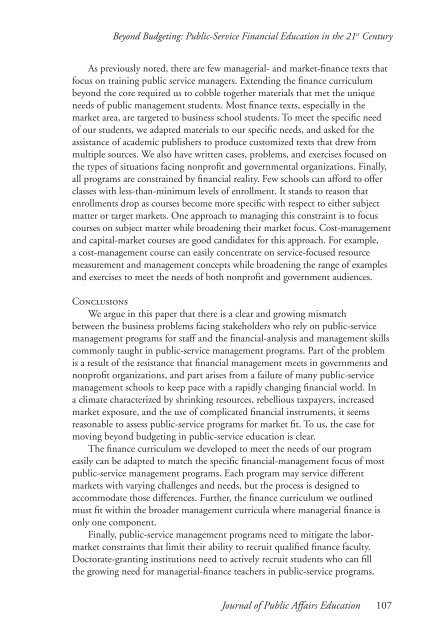Beyond Budgeting: Public-Service Financial Education in the 21st ...
Beyond Budgeting: Public-Service Financial Education in the 21st ...
Beyond Budgeting: Public-Service Financial Education in the 21st ...
Create successful ePaper yourself
Turn your PDF publications into a flip-book with our unique Google optimized e-Paper software.
<strong>Beyond</strong> <strong>Budget<strong>in</strong>g</strong>: <strong>Public</strong>-<strong>Service</strong> <strong>F<strong>in</strong>ancial</strong> <strong>Education</strong> <strong>in</strong> <strong>the</strong> 21 st Century<br />
As previously noted, <strong>the</strong>re are few managerial- and market-f<strong>in</strong>ance texts that<br />
focus on tra<strong>in</strong><strong>in</strong>g public service managers. Extend<strong>in</strong>g <strong>the</strong> f<strong>in</strong>ance curriculum<br />
beyond <strong>the</strong> core required us to cobble toge<strong>the</strong>r materials that met <strong>the</strong> unique<br />
needs of public management students. Most f<strong>in</strong>ance texts, especially <strong>in</strong> <strong>the</strong><br />
market area, are targeted to bus<strong>in</strong>ess school students. To meet <strong>the</strong> specific need<br />
of our students, we adapted materials to our specific needs, and asked for <strong>the</strong><br />
assistance of academic publishers to produce customized texts that drew from<br />
multiple sources. We also have written cases, problems, and exercises focused on<br />
<strong>the</strong> types of situations fac<strong>in</strong>g nonprofit and governmental organizations. F<strong>in</strong>ally,<br />
all programs are constra<strong>in</strong>ed by f<strong>in</strong>ancial reality. Few schools can afford to offer<br />
classes with less-than-m<strong>in</strong>imum levels of enrollment. It stands to reason that<br />
enrollments drop as courses become more specific with respect to ei<strong>the</strong>r subject<br />
matter or target markets. One approach to manag<strong>in</strong>g this constra<strong>in</strong>t is to focus<br />
courses on subject matter while broaden<strong>in</strong>g <strong>the</strong>ir market focus. Cost-management<br />
and capital-market courses are good candidates for this approach. For example,<br />
a cost-management course can easily concentrate on service-focused resource<br />
measurement and management concepts while broaden<strong>in</strong>g <strong>the</strong> range of examples<br />
and exercises to meet <strong>the</strong> needs of both nonprofit and government audiences.<br />
Conclusions<br />
We argue <strong>in</strong> this paper that <strong>the</strong>re is a clear and grow<strong>in</strong>g mismatch<br />
between <strong>the</strong> bus<strong>in</strong>ess problems fac<strong>in</strong>g stakeholders who rely on public-service<br />
management programs for staff and <strong>the</strong> f<strong>in</strong>ancial-analysis and management skills<br />
commonly taught <strong>in</strong> public-service management programs. Part of <strong>the</strong> problem<br />
is a result of <strong>the</strong> resistance that f<strong>in</strong>ancial management meets <strong>in</strong> governments and<br />
nonprofit organizations, and part arises from a failure of many public-service<br />
management schools to keep pace with a rapidly chang<strong>in</strong>g f<strong>in</strong>ancial world. In<br />
a climate characterized by shr<strong>in</strong>k<strong>in</strong>g resources, rebellious taxpayers, <strong>in</strong>creased<br />
market exposure, and <strong>the</strong> use of complicated f<strong>in</strong>ancial <strong>in</strong>struments, it seems<br />
reasonable to assess public-service programs for market fit. To us, <strong>the</strong> case for<br />
mov<strong>in</strong>g beyond budget<strong>in</strong>g <strong>in</strong> public-service education is clear.<br />
The f<strong>in</strong>ance curriculum we developed to meet <strong>the</strong> needs of our program<br />
easily can be adapted to match <strong>the</strong> specific f<strong>in</strong>ancial-management focus of most<br />
public-service management programs. Each program may service different<br />
markets with vary<strong>in</strong>g challenges and needs, but <strong>the</strong> process is designed to<br />
accommodate those differences. Fur<strong>the</strong>r, <strong>the</strong> f<strong>in</strong>ance curriculum we outl<strong>in</strong>ed<br />
must fit with<strong>in</strong> <strong>the</strong> broader management curricula where managerial f<strong>in</strong>ance is<br />
only one component.<br />
F<strong>in</strong>ally, public-service management programs need to mitigate <strong>the</strong> labormarket<br />
constra<strong>in</strong>ts that limit <strong>the</strong>ir ability to recruit qualified f<strong>in</strong>ance faculty.<br />
Doctorate-grant<strong>in</strong>g <strong>in</strong>stitutions need to actively recruit students who can fill<br />
<strong>the</strong> grow<strong>in</strong>g need for managerial-f<strong>in</strong>ance teachers <strong>in</strong> public-service programs.<br />
Journal of <strong>Public</strong> Affairs <strong>Education</strong> 107
















